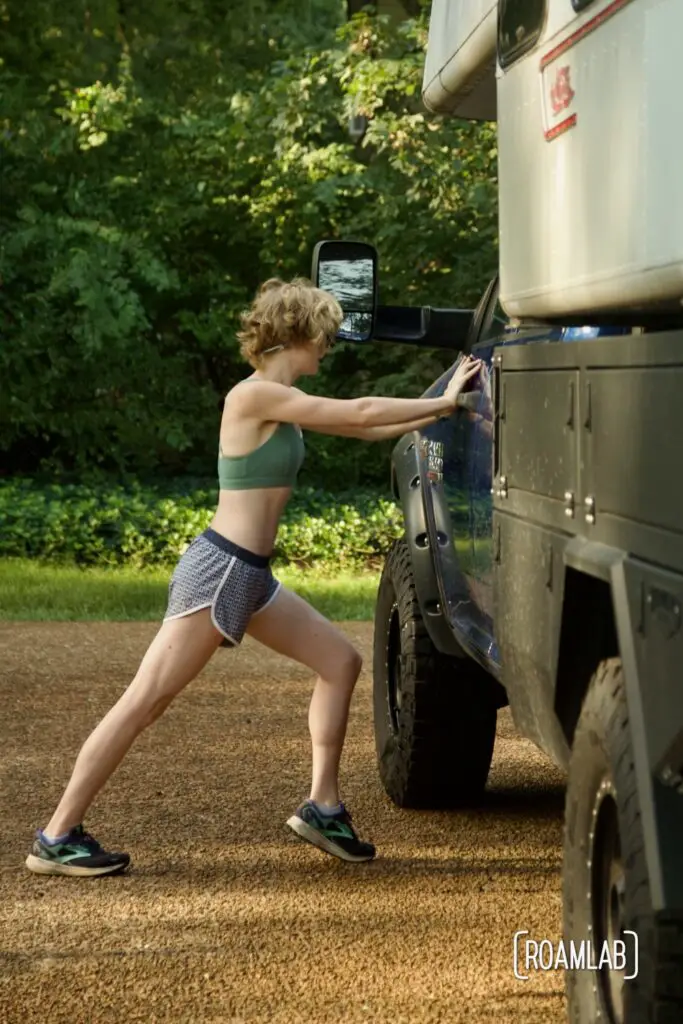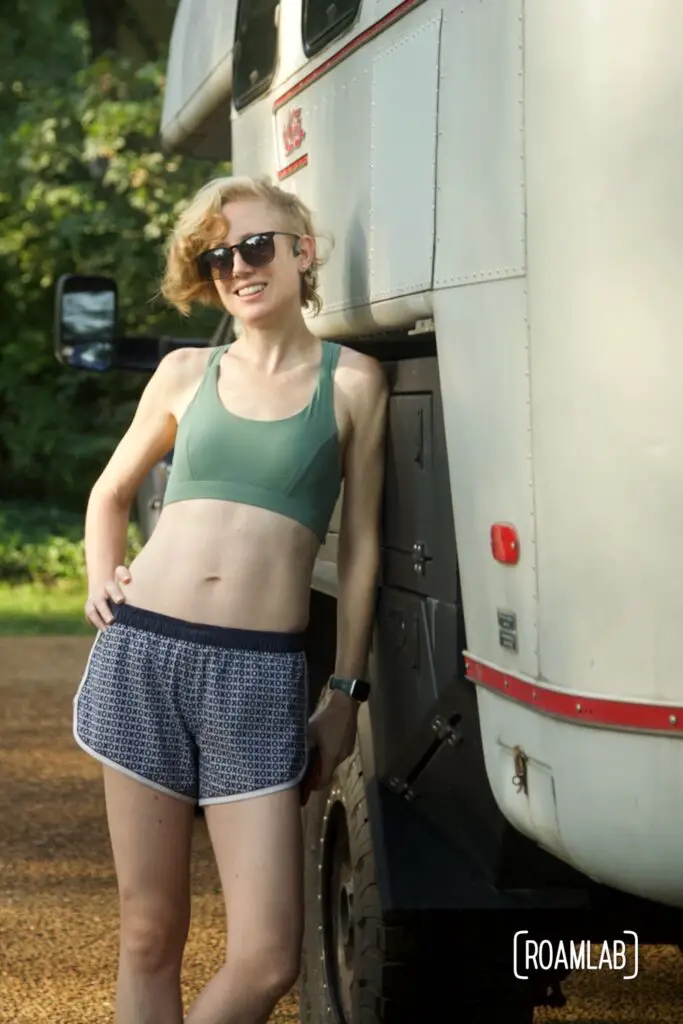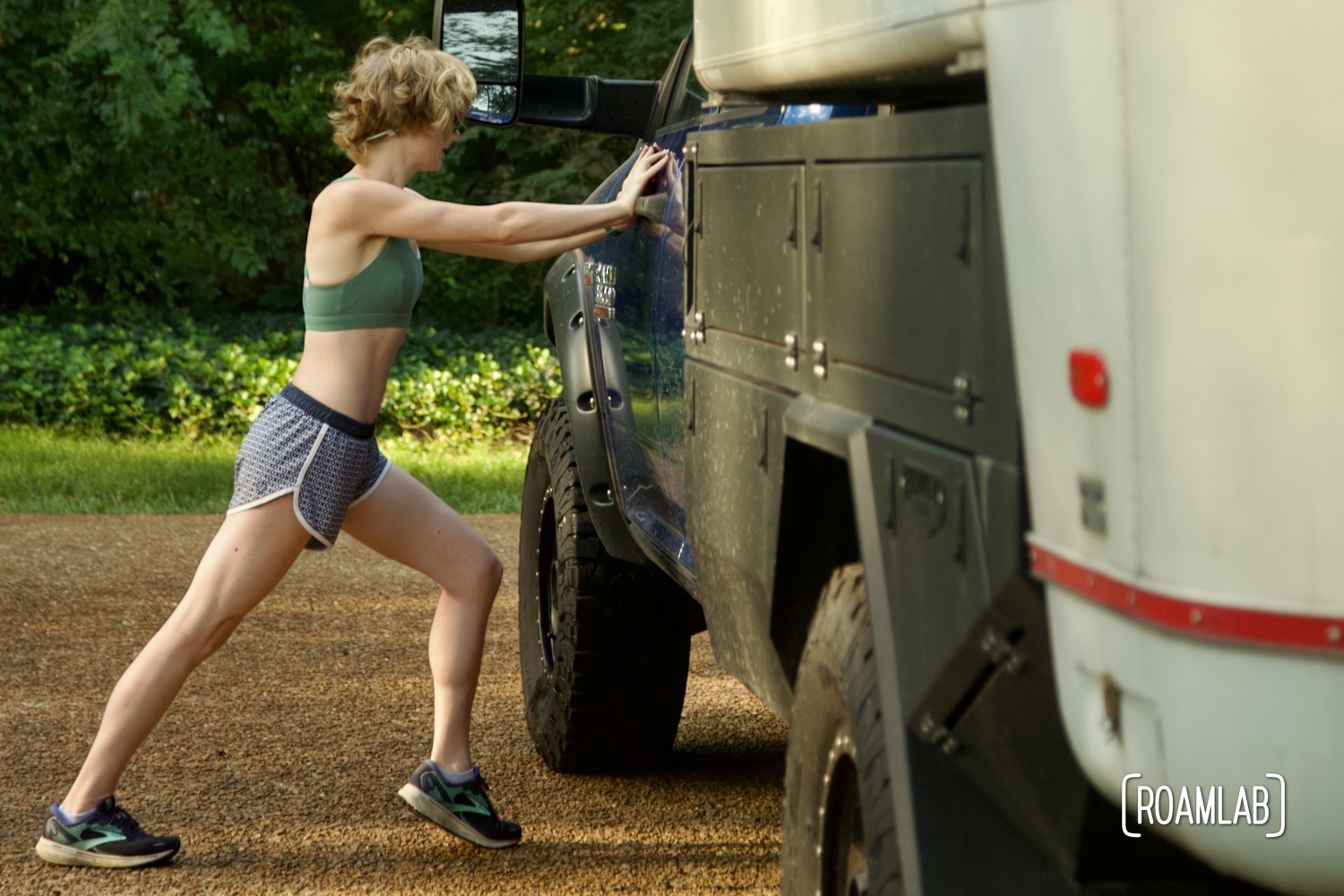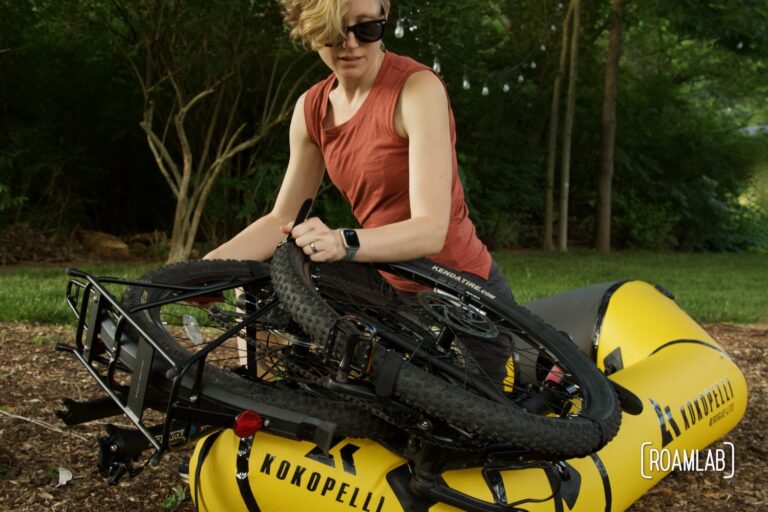There is no shortage of reasons why a training schedule may not go to plan. Life events, work obligations, weather, access, illness, and travel can all sideline a regimen. In our case, however, the starting date just seemed to creep up on us. And that’s why we only had a couple of months to train for our first ultra marathon.
An ultra-marathon is any race longer than the 26.2-mile distance that defines a marathon. In our case, we are running a 50K. That’s 31.07 miles of single-track dirt trails (and a little bit of pavement). It’s a completely different game from the paved roadways that we ran last spring for our first marathon. Along with distance, we are training for technical running over rocks, roots, and other uneven terrain. Fortunately, the race we are participating in is a relatively flat course, with only a little over 1000 feet of elevation. But hopping over roots and between boulders still takes a lot of extra energy.
With a different distance and terrain, our training looks a little different from our marathon training. We are still running a fairly tight training schedule, gradually increasing our weekly distance run. But trail running calls for new gear to break in and lessons learned in the process. We are also tweaking our supplement regimen based on new research. And, of course, any training wouldn’t be complete without a few aches and pains that we have to handle. And this time, we have a few that threaten the whole endeavor.
Training Schedule
As with our last race, we turn to Chat GPT as our coach to suggest a training schedule. As noted earlier, we’re a little late to the training game. Many will allow half a year to train for an ultra marathon, maybe even longer, depending on the difficulty and distance. Granted, this is a 50K and considered an entry-level distance for first-time ultra runners. Both Chris and I have a solid running base before we settle into a focused training regimen.
I treated our marathon training schedule like a holy writ and tried my absolute best to do whatever was prescribed for the day. This time around, I’m a little more lax. I make a point to roughly run the distances prescribed, though I vary the days based on convenience and ability. (More on that when we start talking about injuries).
One training concept we encountered while researching ultra marathons is split long runs. The bread and butter of any long-distance training is the weekly “long run.” It’s often a once-a-week exertion. The distance of each weekly run progressively builds up to a final long run, two weeks before the race, representing 2/3 of the actual race distance. At certain distances, however, it simply doesn’t make sense to attempt to run 2/3 of the actual race during training. Instead, we can gain a lot of the same benefits by splitting the distance between two back-to-back days.
In my penultimate long run, I cover 17 miles one day and 14 miles on the second, effectively running the full distance in two days. Pleased with the results, on my final long run, I cover 20 miles one day and… take a rest day. That 20 miles wrecked me and I’ve also learned that some days, should just be rest days. Like today, the day I’m writing this post, one week before the final 50K.

Final Two-Month Training Schedule
Week 1-2: Build Endurance
- Monday: 6-8 miles easy pace
- Tuesday: Cross-Training
- Wednesday: 8-10 miles at a moderate pace
- Thursday: Rest or easy 4-5 miles
- Friday: 6-8 miles easy pace
- Saturday: 12-15 miles long run at an easy pace
- Sunday: Rest
Week 3-4: Increase Mileage
- Monday: 8-10 miles easy pace
- Tuesday: Cross-Training
- Wednesday: 10-12 miles at a moderate pace
- Thursday: Rest or easy 4-5 miles
- Friday: 8-10 miles easy pace
- Saturday: 16-18 miles long run at an easy pace
- Sunday: Rest
Week 5-6: Peak Phase
- Monday: 10-12 miles easy pace
- Tuesday: Cross-Training
- Wednesday: 12-15 miles at a moderate pace
- Thursday: Rest or easy 4-5 miles
- Friday: 10-12 miles easy pace
- Saturday: 20-24 miles long run at an easy pace
- Sunday: Rest
Week 7: Taper
- Monday: 6-8 miles easy pace
- Tuesday: Cross-Training
- Wednesday: 8-10 miles at a moderate pace
- Thursday: Rest or easy 4-5 miles
- Friday: 6-8 miles easy pace
- Saturday: 12-15 miles at an easy pace
- Sunday: Rest
Week 8: Race Week
- Monday: 4-6 miles easy pace
- Tuesday: Cross-Training or Rest
- Wednesday: 6-8 miles at a moderate pace
- Thursday: Rest or easy 4-5 miles
- Friday: 3-5 miles easy pace
- Saturday: Race Day!
- Sunday: Rest
Running Gear
I tend to run in running shorts, a sports bra, and standard road shoes. It’s served me well for the past couple of years. But we aren’t on the road anymore and the terrain and distance change our needs.
Trail Shoes
The most obvious difference is shoes. We are running on a combination of dirt, rock, and pavement. I’ve already slipped a few times while running over rocks in my old street running shoes. The tread is okay on pavement, but I need more traction to cover this variable terrain. In this case, that means I get my first Hokas: a pair of Speed Goats in a retired color, so they are on sale! Ya!
The difference is undeniable. Walking on the carpet, I can hear the lugs disconnecting from the woven flooring like velcro tearing apart. On the trail, I find a steady purchase on everything from roots to rocks. And the bright colors make me feel faster than my grey Asics.
Hydration Vest
Next up: hydration. I have been running with a pair of handhelds to hold my water with pockets for my phone and gels. But with this long race ahead of us and the many long runs in between, we want a simpler hydration solution with the potential to expand for longer, more demanding trails in the future. So, rather than starting cheap, as is our usual test for new types of gear, we jump all in with the Solomon ADV SKIN 12 hydration vest. The “12” stands for how many liters of water it holds but it also includes a carrying pocket for an additional water badder in the back.
But this vest does so much more than just hold water. It has more pockets and straps than I can shake a stick at. A lot of it isn’t even necessary for this 50K but will come in handy as we start tackling longer, unsupported runs in the future.
That said, the vest is designed to be breathable rather than soft. So, the next thing I need is an undershirt.
Running Shirt
My sports bras won’t protect me from the hydration pack’s chaffing, so now I need a light running shirt with a high neckline to protect any skin that might rub against the vest. Fortunately, I find a fun, bright orange generic running shirt at REI. I don’t know how long it will be for this world, though. I already see the pack’s handiwork on the shirt’s worn shoulders.
One Last Surprise
I thought I was set until one of our final training runs on the course itself. Several times I had to pause to pull little sticks and pebbles out of my shoes. Which finally has me looking at gaiters. Usually, I think of gaiters as weather considerations, when dealing with mud and the like. But the dust and debris can be just as distracting. A week and a half before the race, I pick up a pair of lightweight gaiters that hook into my shoelaces and secure to the shoe bottoms with some thin elastic cord. I thought they would be annoying, but they are reasonably lightweight and easy to forget while running.
The only thing I haven’t had to buy specifically for this course are my shorts. So at least I have something well-loved and familiar item for the final race. Granted, everything should be well worn before the race, so I take most running outings as an opportunity to break in my shoes, shirt, vest, and gaiters.

Nutrition
Anyone will tell you that nutrition is a critical part of training. Fueling our bodies is key in preparation, execution, and recovery. In general, that means a lot of complex carbohydrates, lean proteins, and veggies while training and carb loading in the days immediately before the competition. More particularly, we also are testing out fuels while running to keep our energy stores up and supplements to aid in performance and recovery.
Fueling
I suspect that fueling while running is one of those particularly divisive subjects. It is both incredibly important and personal. So I don’t see too much need to dive deeply into this aside from acknowledging its importance. We have calorie drink powders, gummies, and gels and try to take in at least 100 calories per 5 miles. During the marathon, we fueled by time elapsed but using mile markers is a little simpler since our watches alert us to each mile split.
The event will also have aid stations. Having never run an ultra before, we plan to play the aid stations by ear. This is only a 50K, so fueling is important but not to the level of burgers and burritos that we’ve seen in some ultras.
Daily Supplements
During this training cycle, we’ve doubled down on supplementation. There’s no shortage of supplements out there. And most produce little more than expensive pee. While pre and post-workout blends are convenient, they are also mostly cheap fillers. So we are breaking down our supplementation by individual ingredients.
It’s worth noting here that sports nutrition is still a relatively young science and, while there are a lot of athletes and influencers that will speak with confidence on their ideal regimen, that confidence is misplaced. There is more we don’t know than do know. New discoveries are constantly being made. But there is a fairly large gap between valid scientific discoveries and the consumer market. So, we are referring directly to research papers and assembling our own concoctions.
Some supplements are obvious. Some…less so.
Creatine
Creatine is often a joke evoked around bodybuilding and other muscle-centric activities. But there’s a reason for it. Creatine is scientifically proven to aid in building muscle mass. And while I’m not looking to make my debut on Venice Beach or hang around Gold’s Gym, muscles still matter in endurance running.
Beta-Alanine
Beta-alanine aids in the production of carnosine, a compound that helps regulate the build-up of acid in muscles. Back in the day, athletes found that sodium bicarbonate (baking soda) would help neutralize the buildup of acid in muscles and, thus, fatigue. But it also irritates the stomach. Beta-Alanin, on the other hand, manages the same action without stomach irritation. It does cause a strange skin-tingling sensation that Chris likes and I do not. But we consider it worth including in our regimen.
Beet Root Powder
Beet Root powder is having a bit of a moment. I hear about it in a lot of corners of the internet and nutrition booths. Which makes me, deeply skeptical. And yet, this appears to be one of the trendy supplements that can make a difference. It’s not a panacea that will make you superhuman like some influencers might indicate, but it can aid in endurance and focus.
Collagen Hydrolysate
Collagen seems to show up in everything: injections, skin creams, and the occasional baked good. Most of the time, I encounter it in the context of skin smoothing. Which, yes, it can help. (Though, to be clear, it is not something that works transdermally, so all those creams and lip balms are still a scam.). That said, research indicates that collagen appears to aid in alleviating joint pain and potentially stimulate cartilage repair. To be fair, pain is a very subjective metric and is hard to control in studies. The positive results from these studies give us reason to hope that this can help us while we work through our own joint troubles. Though it is one of the less certain supplements we are using.
Performance Supplements
Along with my daily concoction of supplements, there are others that I take during a long run and plan to use during the race. At this point, I’m no longer worried about building muscle, improving efficiency, and endurance. This is about suppressing pain and improving short-term performance. Some, are pretty obvious.
Caffeine
A lot of people don’t think of caffeine as a supplement because it is a normal part of every day. But it is. And it’s one of the most effective supplements out there for performance when properly used. I don’t drink coffee. But I do drink soda and have caffeinated hydration supplements to help keep me energized and alert during a race. Caffeine is the first thing I ingest on race day (it speeds up that initial bowel movement so you can do most of your business at a comfortable location rather than a port-a-potty at the start line.) During the race, it’s an occasional pick-me-up to keep me alert when I start lagging.
Salts
Salts get overused in a lot of sports but after sweating for an hour, I start supplementing. Hyponatremia, or low sodium concentration in the blood is a common problem among ultra-endurance athletes and can lead to serious muscle cramping and bodily breakdown. It may also explain those hallucinations some ultra runners talk about.
In most cases, we can get enough salt simply from eating and drinking. But, the more restricted our diets are, the more important it is to be aware of our sodium levels. So, if we stop at an aid station and down a cup of broth, we’ll likely be fine. But we also have single-serving packets to add to our drinks. (Not to mention, the packets have additional flavoring to cover up the TERRIBLE taste of the water at the race location.)
Acetaminophen
Better known as its branded incarnation, Tylenol, Acetaminophen isn’t a daily supplement but it’s certainly a race day performance enhancer. Not only can acetaminophen dull the aches and pains of joints while running, but it also helps with muscle soreness to improve overall endurance. I don’t take painkillers while training. If I hurt, I rest. But on race day, acetaminophen is my painkiller of choice.
Injuries
And of course, there are injuries. Well, not of course. It’s possible to train injury-free. Injuries are often an indication of overtraining rather than accidents. We may have had a bit of both.
The Sole Problem
My knee for example. That looks like it’s partially my fault in that it’s probably my shoe’s fault. The shoes that I bought for the marathon to better support my knee did their job a little too well. And while the part of my knee that was sore in the spring is now complaint-free, its opposing side has picked up the slack. It appears to be a tendon problem, sore at the beginning of a run but fine once warmed up. So long as I don’t run too hard, I can run pain-free. Now that I have new, neutral shoes and take care to limber up, my knee has strengthened as I train.
Balancing Recovery
Chris’s ankle, however, is a different story. It, too, is a tendon problem. But, while mine is gradually resolving with a little consideration, his was aggravated to the point that it has limited his training and resulted in a few doctor’s appointments. The good news: the doctor cleared him to run the 50K. The bad news, to allow his ankle to heal as much as possible, he is only doing a fraction of the training I am and almost exclusively on roads.
Ideally, we would train on trails where we can gain experience on uneven terrain. But that’s exactly what aggravates his ankle. So, we’ve only done a few short trail runs. Instead, Christ is mostly training cardio on the bike. It’s not quite the same as running, but he is staying strong and does join me on the long runs once a week.
Impact
And finally, there is the accident. A little over a month before the 50K, I bought my new trail shoes and finally had a chance to try them out on the trail. We drove over to the actual race course to run 8 miles of the route. I ran a little less than 4. At about 3.75 miles under a blistering summer sun, I didn’t lift my foot high enough to clear a low-lying rock and my new shoes did exactly what they are designed to do: grip. My foot might as well have been nailed to that rock. Fortunately, I fell forward into the dirt. I suppose it was instinct that led me to push off with my left hand so that I landed on my right side rather than face-planting into the dirt. I can see skid marks from tiny bits of gravel on my shoulder, elbow, and thigh, but no deep cuts. (It’s also my first day running with my hydration vest which appeared to take a bit of the brunt from my shoulder impact.)
On the upside, I fell only a quarter of a mile from a bathroom with running water where I could wash off my scrapes. I’m initially focused on my right hand, which has the deepest cuts. No serious bleeding but, it’s still a very vulnerable spot to have exposed. But these scrapes can heal over in a matter of days and certainly don’t have to slow my training.
My bruised hip, however, does. It’s clearly a deep bruise. I don’t even see much color around my hip. Instead, I just feel the tension from the swelling. I throw my training schedule out while focusing on healing my hip: a rest day and then several days of gentle walking and stretching. But it’s just a matter of time before I start lightly jogging and running again. Even now, more than a month later, I still have twinges from my hip. But I was able to get back on track and finished my training schedule strong.
Lessons Learned
Now, recovering in preparation for the race in a week, I feel confident. But there’s been a few surprising lessons. Training for a fall race is so much harder than training for a spring race. Ramping up my running in the winter was easy. I just needed to wear enough layers to properly regulate my temperature. In the summer, though, there are only so many layers I can take off. Sure, morning runs are easier than afternoon runs. But they are still hot compared to any timed run in the winter.
A training schedule is a guide, not a sentence. Establishing a regular daily training regimen helped keep my days structured but knowing that I called the shots allowed me to rest when my body needed it. Training through an injury without adjustment would have resulted in worse injuries that might have prevented Chris and me from making it to the start line at all.
As it is, we feel strong. We hit our key benchmarks. And we look forward to our race in a week. We have a packing list and a plan. But also backup plans. We want to run a sub-5 hour 50K and cross the finish line together. But we also recognize that our health is more important than our finish times. If either of us is injured, we’ve already talked through what circumstances one of us would continue alone to keep time versus both of us slowing down to finish together or, worst case, DNFing for the safety of the other.
We think our goals are hard but achievable. We’ll find out in a week.
Resources
- Alfonso E. Bello & Steffen Oesser (2006) “Collagen hydrolysate for the treatment of osteoarthritis and other joint disorders:a review of the literature.” Current Medical Research and Opinion, 22:11, 2221-2232, DOI: 10.1185/030079906X148373
- Clark, Kristine L et al. “24-Week study on the use of collagen hydrolysate as a dietary supplement in athletes with activity-related joint pain.” Current medical research and opinion vol. 24,5 (2008): 1485-96. doi:10.1185/030079908×291967
- Domínguez, Raúl et al. “Effects of Beetroot Juice Supplementation on Cardiorespiratory Endurance in Athletes. A Systematic Review.” Nutrients vol. 9,1 43. 6 Jan. 2017, doi:10.3390/nu9010043
- Grgic, Jozo, and Pavle Mikulic. “Effects of Paracetamol (Acetaminophen) Ingestion on Endurance Performance: A Systematic Review and Meta-Analysis.” Sports (Basel, Switzerland) vol. 9,9 126. 6 Sep. 2021, doi:10.3390/sports9090126
- Zdzieblik, Denise et al. “The Influence of Specific Bioactive Collagen Peptides on Knee Joint Discomfort in Young Physically Active Adults: A Randomized Controlled Trial.” Nutrients vol. 13,2 523. 5 Feb. 2021, doi:10.3390/nu13020523





